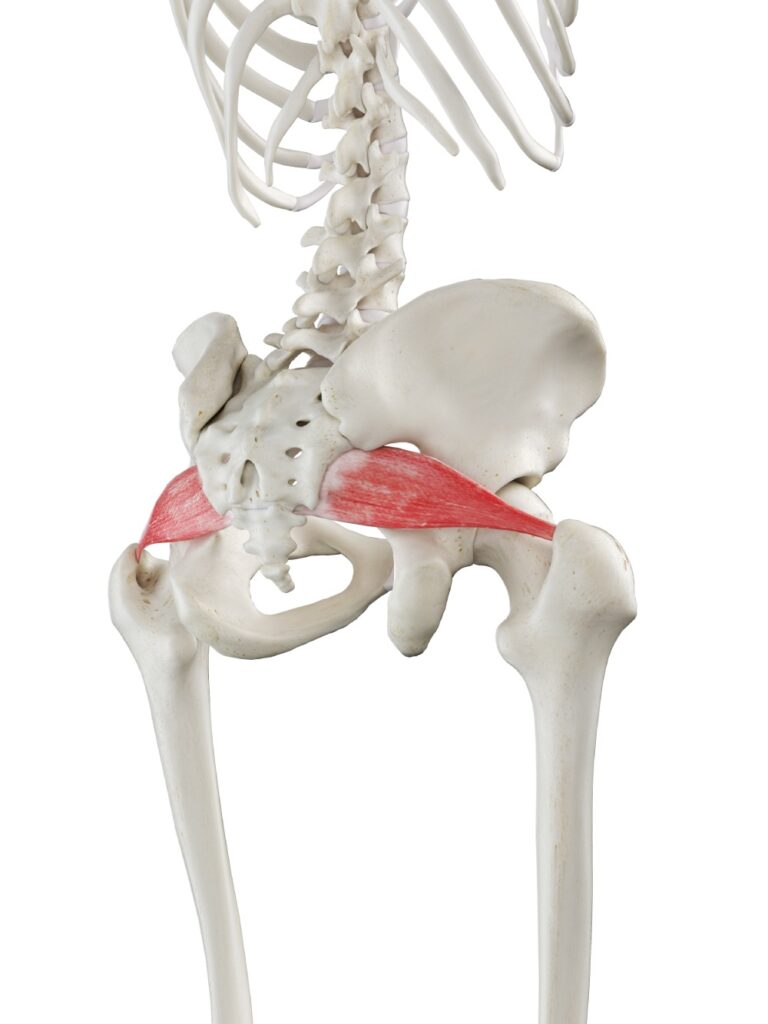Introduction To Runners Piriformis Syndrome
Your body is a finely tuned machine, with every muscle working in sync to propel you forward as you run or jog.
A key muscle which helps in stabilising the hip as you run is the Piriformis Muscle – a pear shaped muscle connecting your femur to your pelvis, spanning the buttock region.
Its primary function is to rotate your hip during walking or running, ensuring smooth and fluid movements.
However, despite its crucial role, the Piriformis Muscle sometimes becomes injured in runners and athletes.
You may have heard people complain about a sharp pain in their buttocks, particularly during activities like running, jogging, or climbing stairs. In these cases, the diagnosis may be the condition: Runners Piriformis Syndrome.
Runners Piriformis Syndrome is an irritated piriformis muscle. It is common in runners and athletes and can cause ongoing pain and a hampering of running performance if not treated.
What follows is a discussion on Piriformis Syndrome and its impact on running.
What is Piriformis Syndrome?
Piriformis Syndrome is an injury or irritation of the piriformis muscle situated in the buttock region. This condition can lead to cramping and persistent pain in the buttocks area. If left untreated, the affected piriformis muscle may also exert pressure on the nearby sciatic nerve, making the problem worse and causing Sciatica.
Individuals experiencing this syndrome often report discomfort, numbness, and tingling in the buttock, radiating down the back of the thigh down to the foot.
Understanding the symptoms and early intervention is crucial in managing this condition effectively.
In this article, we delve a little deeper into this syndrome, exploring its causes, symptoms, and potential treatment options to alleviate pain and restore normal function.
How does running cause Piriformis Syndrome?
In pursuing an active lifestyle, it’s common for individuals to engage in activities like running, jogging, and other physically demanding exercises.
However, pushing our bodies beyond their limits can sometimes lead to injuries, and one such injury often encountered by avid runners, especially long-distance runners or those who increase the intensity of running quite rapidly, is Piriformis Syndrome.
The piriformis muscle often becomes injured with repetitive movements and overuse of the muscle, and all of a sudden running or sitting suddenly become quite painful.
It is a type of Repetitive Strain Injury (RSI) to the Piriformis muscle which results in the development of Piriformis Syndrome..
Understanding the Anatomy of the Piriformis Muscle
This muscle resides deep in the centre of the hips, positioned just beneath the prominent gluteus maximus muscle.

Location and Function of the Piriformis Muscle
The piriformis muscle plays a crucial role in walking and running mechanics. Originating from the lower spine, it spans and connects to each femur’s upper region.
It plays a vital role in facilitating outward rotation of the hip when standing. This movement allows the thigh and knee to move away from the body, contributing to the strength and stability of the hip joint.
When the thigh is raised during hip flexion, the Piriformis muscle becomes an internal rotator of the hip.
These movements are essential in turning your leg and foot outward as you walk, allowing for a smooth transfer of body weight to the other side.
In essence, the muscle acts as a vital pivot, contributing to the fluidity and stability of your gait as you move through each step of your journey.
Piriformis Syndrome VS Sciatica
The close connection between the piriformis muscle and the sciatic nerve is relevant to lower body movement. This muscle extends on both sides of the body, contributing to nearly every lower body movement, while the sciatic nerve courses beneath the muscle.
As the body’s largest nerve, the sciatic nerve originates from the spinal cord, travels under the buttock muscle (Gluteus Maximus), and extends down the back of the legs, reaching the feet.
While this syndrome and sciatic nerve pain share certain common features in their symptoms, it is crucial to distinguish between the two as they represent distinct conditions.
This syndrome often goes misdiagnosed or underrecognized, primarily due to its resemblance to sciatica nerve pain.
Differentiating these conditions is vital to ensure accurate diagnosis and effective treatment, preventing potential mismanagement.
Symptoms of Piriformis Syndrome in Runners
For runners, staying vigilant about potential symptoms of the syndrome is essential. Here are some indicators to watch out for:
- Sitting becomes painful and challenging.
- Experiencing discomfort while climbing stairs or squatting.
- The affected area feels tender and stiff.
- Pain predominantly is concentrated in the centre of the glutes.
- Muscles may tighten and experience spasms.
Common Physical Manifestations
This syndrome is characterised by several common physical indicators, which may include:
- Tenderness spanning across the gluteal area.
- Pain is elicited during when the muscle is stretched, specifically during hip flexion, adduction, and rotation.
- Weakness is accompanied by reduced strength in external rotation and abduction of the hip.
- Pain arising from passive internal rotation of the lower thigh.
How Symptoms may impact a Runner’s performance
For those who take part in Health and Fitness training, running is a vital activity.
Having to stop running due to an injury of the piriformis muscle undoubtedly causes frustration and disappointment.
Following the onset of the Piriformis Syndrome, engaging in physical activities becomes challenging for runners. Even sitting becomes an uncomfortable experience as the muscles are very tender.
The impact on a runner’s professional life can be significant, as walking, running, or sitting properly becomes daunting. However, the good thing is this syndrome can be effectively managed through proper treatment, medications, and lifestyle adjustments.
Timely intervention is crucial, as untreated Piriformis Syndrome may lead to potential nerve damage. By promptly addressing the condition, runners can embark on the path to recovery, regaining their stride and taking steps towards pain-free running.
Causes and Risk Factors of Piriformis Syndrome
Anyone can suffer from Piriformis Syndrome, but the individuals who are at risk include:
- Females, as this syndrome is most likely to develop in females, and the female to male ratio is 6:1.
- Anatomic variations in the positioning and location of the sciatic nerve (occasionally the Sciatic nerve can travel through the Piriformis muscle
- Any direct damage or injury to the hips or buttocks.
- Sitting for long hours.
- Repetitive physical movements like long-distance running, cycling or walking.
Diagnosing Piriformis Syndrome in Runners
This syndrome in runners is frequently identified by assessing distinctive symptoms, including tenderness and inflammation of the gluteal muscles, sharp pain in the centre of the buttocks, and discomfort experienced during walking or running.
A comprehensive physical examination should be conducted, and when necessary, additional investigative steps are often taken, such as ordering X-ray or MRI scans to exclude other pathology and assess the piriformis muscle.
Clinicians can accurately diagnose Piriformis Syndrome through this meticulous approach, enabling them to tailor an effective treatment plan that facilitates the runners’ recovery and ensures their swift return to the track.
Imaging and Other Diagnostic Tests
Different diagnostic tests can be performed to identify Piriformis Syndrome, such as X-ray, MRI, Ultrasound or Nerve Conduction Studies (to exclude a Sciatic nerve issue).
Clinicians can also carry out some Physical Tests around the hip to see how your body reacts to stretching or activating your Piriformis muscles.
How to Heal Piriformis Syndrome Quickly?
There is no certain way to completely heal this syndrome completely however different treatment options can help.
The syndrome doesn’t necessarily need any specific treatment if it’s in the early stage or only causes mild pain. You are advised to rest and avoid physical activities like walking, running or climbing stairs.
However, it is recommended to consult a doctor if the pain won’t go away even after resting or avoiding physical activity.
Some simple exercises to stretch or strengthen the piriformis muscle are also recommended. Doctors also recommend common painkillers like Ibuprofen or Non-steroidal anti-inflammatory drugs to reduce pain and inflammation.
A slight massage of the gluteal area can also help relieve the pain.
Frequently Asked Questions
1-Why are my glutes sore after running?
This is the most common complaint among runners. If your glutes feel sore and achy after running, you may suffer from Piriformis Syndrome. It may be the inflammation and swelling of the piriformis muscle in the centre of your buttock, often triggered by running or walking. It is a common injury among runners and can be very frustrating, but it is treatable.
2-Why do I get a dull ache in the buttocks after running?
Experiencing persistent discomfort in your buttocks following a run is a significant clue that should not be overlooked, as it may indicate the presence of Piriformis Syndrome.
This condition arises due to excessive running, exercise, or prolonged sitting, resulting in irritation and inflammation of the piriformis muscle located in the buttocks.
As a precautionary measure, consider temporarily halting your running routine and seeking medical assistance. Consulting a healthcare professional will enable you to receive proper evaluation and tailored treatment to manage the syndrome.
3-Piriformis Syndrome Exercises to Avoid
Although exercise is important in the recovery from piriformis syndrome, certain activities may aggravate the condition. Running, cycling and deep squats or deadlifts can all irritate the Piriformis muscles, possibly worsening inflammation and pain.
Similarly engaging in high intensity interval training (HIIT) or any other vigorous exercise can potentially worsen the irritation.
It is advised to limit activities such as long distance running or any prolonged sitting that exert pressure on the buttocks. Always pay attention to your body’s pain signals and stop any activity that induces discomfort or pain.
4. My Piriformis Syndrome won’t go away
We frequently see patients in our clinic who tell us that their Piriformis Syndrome won’t go away. When this happens we take a careful history and re-examine the patient. Often we also order a lumbar MRI scan and frequently discover nerve root impingement against a disc herniation being the cause.
In these specific cases the actual diagnosis is Sciatica which has been mis-diagnosed as Piriformis Syndrome and the patient has undergone extensive manual therapy along with associated expenses only do discover the original diagnosis was incorrect
The learning point is if the patient isn’t improving then an image or scan should be performed early
Runners Piriformis Syndrome is something that hampers the ability to run and adversely affects running performance. The key to treating it is having it diagnosed early and treated promptly. If scanning is required (if the patient is not getting better) then a lumbar MRI should be arranged as soon as possible





